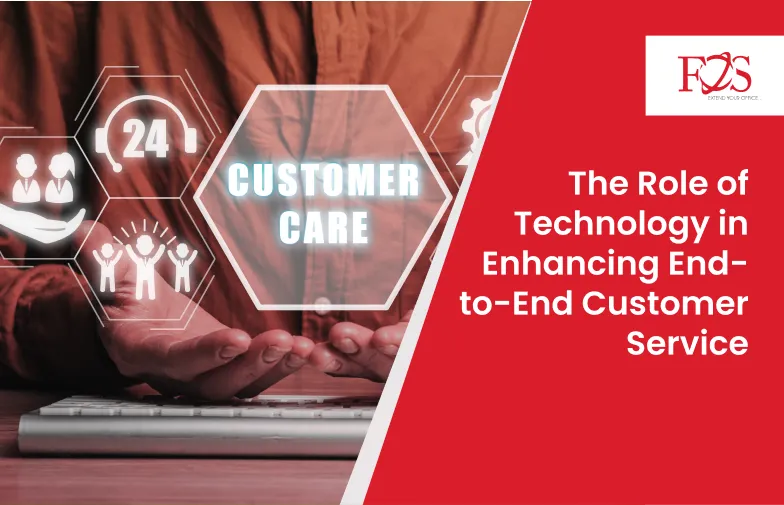
Relations with clients have seen a significant transition in the modern company environment, emerging as a strategic differentiator and a crucial factor in success.At the heart of this transformation is technology, which has revolutionized how businesses engage, support, and delight their customers. From seamless multichannel communication to predictive analytics, and from AI-powered chatbots to virtual reality experiences, technology has taken center stage in enhancing end-to-end customer service. In this exploration, we uncover the multifaceted role of technology in shaping a new era of customer-centric experiences.
Connecting the Gap with Flawless Multichannel Communication
Gone are the days when customers relied solely on phone calls to connect with businesses. Today, technology has ushered in a diverse array of communication channels, enabling customers to engage with brands seamlessly. From social media platforms like Twitter and Facebook to instant messaging apps like WhatsApp and Messenger, businesses can now meet customers where they are, providing timely and relevant assistance across various channels. This multichannel approach ensures that customers experience consistent support, regardless of their preferred mode of communication.
AI-Powered Chatbots: The Future of Instant Assistance
The rise of artificial intelligence (AI) has given birth to intelligent chatbots that are transforming the customer service landscape. These virtual assistants are capable of understanding natural language, context, and intent, allowing them to provide instant assistance and resolve queries around the clock. AI-powered chatbots not only reduce customer wait times but also free up human agents to focus on more complex tasks, leading to increased efficiency and overall customer satisfaction.
Predictive Analytics: Anticipating Customer Needs
Predictive analytics, fueled by advanced data analysis and machine learning, empowers businesses to anticipate customer needs and preferences. By analyzing historical data and customer behaviors, businesses can proactively recommend products, services, and solutions tailored to each individual. This level of personalization not only enhances the customer experience but also demonstrates a deep understanding of their unique requirements, fostering a sense of loyalty and trust.
Virtual Reality (VR) and Augmented Reality (AR): Immersive Experiences
Virtual reality and augmented reality technologies have transcended entertainment and found their way into customer service. Businesses are leveraging these technologies to provide immersive experiences that enable customers to interact with products in a virtual environment. For instance, customers can “try on” clothes using AR, visualize furniture placement in their homes, or receive step-by-step instructions for troubleshooting. These technologies enhance customer understanding, reduce uncertainty, and contribute to a more satisfying experience.
Real-Time Issue Resolution: Swift and Efficient Solutions
Modern technology facilitates real-time communication and collaboration, enabling customer service agents to address issues promptly. When a customer faces a challenge, agents can seamlessly connect with experts across departments to find solutions. This agile approach minimizes downtime, reduces customer frustration, and ensures that issues are resolved in a timely manner, contributing to a seamless customer journey.
Enhanced Self-Service Options: Empowering Customers
Technology has empowered customers with self-service options that put them in control of their interactions. Interactive FAQs, comprehensive knowledge bases, and online tutorials enable customers to find answers to their questions independently. This not only saves time but also empowers customers to resolve issues on their own terms, leading to increased satisfaction and a sense of empowerment.
IoT and Proactive Support: Preventing Issues Before They Arise
The Internet of Things (IoT) has introduced a new dimension to customer service—proactive support. Connected devices can transmit real-time data to service centers, allowing businesses to detect and address potential issues before they escalate. For example, IoT-enabled appliances can send diagnostic data to service centers, enabling technicians to diagnose and resolve problems remotely. This proactive approach not only enhances customer satisfaction but also reduces service costs and downtime.
Data-Driven Insights: Informed Decision-Making
Technology’s data collection and analysis capabilities provide businesses with valuable insights into customer behavior, preferences, and pain points. By leveraging these insights, businesses can make informed decisions, refine their offerings, and tailor their strategies to better meet customer needs. Data-driven decision-making ensures that the customer remains at the center of every innovation, leading to enhanced experiences and sustained loyalty.

Wrapping Up: Orchestrating a Technological Symphony of Customer Service Excellence
In the grand symphony of modern customer service, technology plays a pivotal role, acting as the conductor that harmonizes various elements to create a seamless and memorable experience. From the initial point of contact to issue resolution and beyond, technology weaves a tapestry of interactions that cater to the needs, preferences, and expectations of customers.
As businesses continue to embrace technology, they embark on a journey of customer-centricity, where each interaction is an opportunity to build trust, foster loyalty, and leave a lasting impression. The orchestration of technology-driven customer service is not just about transactions; it’s about creating meaningful relationships that transcend individual interactions.
In this symphony, customers are not mere spectators; they are active participants, co-creators of their experiences. As technology continues to evolve, businesses have a unique opportunity to craft a melody of satisfaction, a crescendo of delight that resonates with customers long after the final note has been played.
As the curtain falls on this exploration, the stage is set for a future where technology remains an integral part of the customer service repertoire—a future where businesses continue to innovate, adapt, and orchestrate a technological symphony that reflects their unwavering commitment to customer satisfaction and excellence.